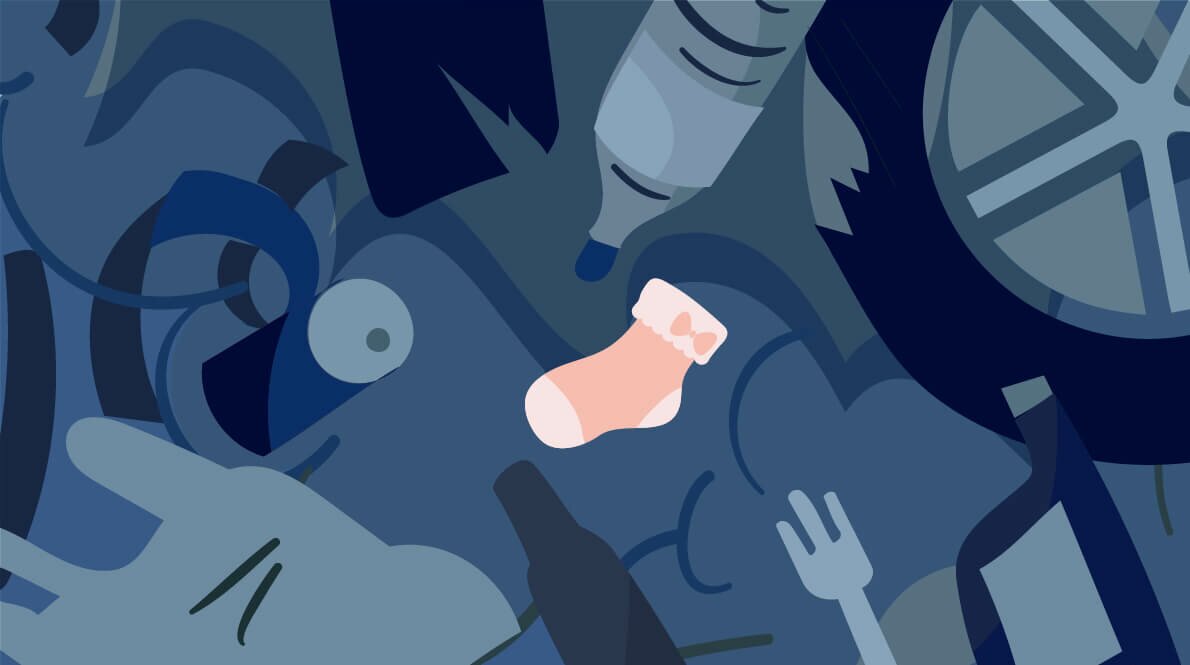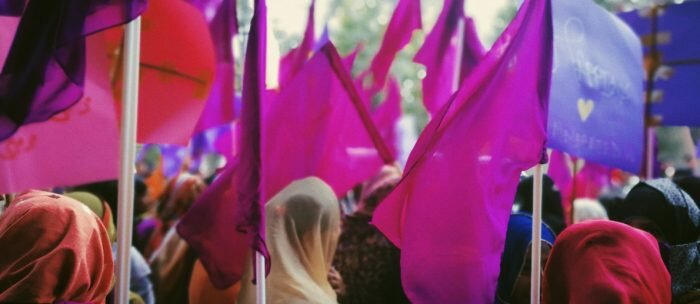
Karachi’s Missing Children
Why are rising rates of infanticide not a pressing issue for Karachi's police?
[TW: Violent imagery, death]
Station House Officer Nadeem Baig met me at his office at the Liaqatabad police station in Karachi – a region where a number of infanticide cases have been reported. I sat down, he offered me a cup of tea, we exchanged pleasantries and he told me about his daughters. “I’m a very fortunate man,” he said. “I’m the father of four daughters. People in this country don’t value their girls.”
He then pulled out his cellphone to show me a picture of an infant his officers found in a heap of trash under the Liaquatabad flyover on April 24 of this year. Lying in the trash for several days, the body had decomposed, and the child’s head had been severed, probably by animals, Baig said. It was a baby girl. “Tell me,” Baig asked, “Who will fight for this unwanted child?”
On April 26, 2018, The News ran an explosive report claiming Karachi had “become a killing field for girls.” The report went on to state that between January 2017 to April 2018, Edhi Foundation and Chhipa Welfare Organisation – the two largest welfare organisations in the city – had found 345 newborn babies dumped in the garbage across the city. Ninety nine per cent of the abandoned infants were girls, the report stated.
Only one case of infanticide managed to make it to the press in 2019: an incident that took place in the upper-middle class neighborhood of Defence in February of this year. According to a news report published in the Express Tribune, 28 year-old Shakila drowned her two-and-a-half-year-old daughter into the deep end of the sea near the Farhan Shaheed Park in Defence Phase VIII. A resident of Golimar, Shakila had been thrown out of her house by her husband after her daughter was born in 2016. In a public statement that was aired on television later that day, Shakila admitted to murdering her daughter, but added that she was mentally ill herself and claimed that her actions were a result of distress. Eventually, Shakila was arrested by Sahil Station House Officer Syeda Ghazala. Her husband was not.
According to a 2011 BMC Public Health study co-authored by Farah Qadir, Murad M Khan, Girmay Medhin and Martin Prince, the preference for boys over girls is embedded deep into Pakistan’s culture.
“I’m sure more than 345 cases of infanticide take place in a year in Karachi. They’re grossly under reported,” Khan told me over the phone.
A 2015 Population Council study also found that nine out of ten newborn babies killed in Pakistan in 2010 were girls. The study went on to add that data from all five censuses conducted in Pakistan since 1951 indicated men had consistently been outnumbering women. The latest census conducted in 2017 also cites an unequal number of men and women in the country.
But when I went to verify these statistics at the Edhi Foundation’s offices in Sohrab Goth, Karachi, I found a different story.
In a dark and dingy side-office at the Edhi Foundation’s largest morgue in Karachi, Noman pulled out stacks of dusty registers from a rusty filing cabinet. Leafing through lists of hand-written entries, he read out a series of dates marking days when Edhi Foundation workers found a dead infant in Pakistan’s largest metropolis.
So far this year, according to Noman’s records, Edhi Foundation workers have found 30 cases of infanticide in Karachi – nine were female – the Korangi and Sohrab Goth neighbourhoods top the list. But the Edhi Foundation’s annual statistical compilations of gunshot wound victims, abandoned bodies, victims of drowning and heatstroke and so on, do not include cases of infanticide as a separate category. These numbers are locked up, kept away from the press.
A stocky man in his mid-thirties, Noman has dedicated over a decade of his life to the Edhi Foundation’s sardkhana – an Urdu word that literally translates to “cold room” but colloquially refers to a morgue. His office is located next to the room where ghusl [final ablution] is performed, and the only window in his cramped office overlooks Rashid Minhas road.
Three people – an old man and two young men – knocked on Noman’s window during the hour I spent in his office. They were looking for a place to prepare their loved ones’ bodies for burial and Noman was their first point of contact. He deals with dozens of such cases everyday.
“We’ve received tons of mutilated bodies of infants over the years; some had been chewed by animals, others were wrapped in plastic,” Noman told me. “We washed them and gave them a proper burial.”
While Noman, with about half-a-dozen workers, oversees the preparation of infant bodies for burial, the process of searching for Karachi’s missing children begins 16 miles from the Edhi Foundation’s sardkhana, at the Foundation’s control center on M.A. Jinnah road.
At the control center, a tiny room crammed with desks, chairs, old desktop computers and telephones that never seemed to stop ringing, I met Muhammad Bilal, a bespecled, bearded man in his fifties who has been working for the Edhi Foundation for the past 30 years.
Four large LCD televisions cover one wall, each screen is fixed on a leading news channel. But Edhi workers don’t need to rely on the news. The nonprofit, funded entirely by private donors, bridges the gaping hole left by the absence of a robust public healthcare and emergency medical service provision system, and their hotline number, 115, is on everyone’s lips, almost like a prayer. When disaster strikes in Pakistan’s largest metropolis, the Edhi Foundation’s ambulance drivers and first responders, clad in red, are the first to arrive.
“We get phone calls from across Karachi — sometimes people tell us that there’s a child’s dead body lying around somewhere,” Bilal told me. “Often, by the time our workers reach the site, a child that was alive when we received the call may have expired.”
“I think the number of dead infants our workers find has definitely increased over the years,” Bilal said. “On average, in this city of 20 million, our workers find approximately seven to eight cases of infanticide each month.”
“Data on cases of infanticide is wiped from our system every 24 hours. Why should we gather it, when there has never been an investigation?”
While Bilal estimated that the number of female infants was higher – and had increased over the years – Noman, at the Edhi sardkhana was quick to assert that the number of abandoned infant boys and girls were roughly equal. His statistics, pulled from handwritten columns in a stack of dusty registers, claimed that in 2019, so far, nine cases of female infanticide were brought to Edhi’s morgue, as opposed to 21 cases of male infanticide.
And while the Edhi Foundation was willing to provide some statistics, Chhipa spokesperson Shahid Masood claimed that there was no data on cases of infanticide in their repository.
“Data on cases of infanticide is wiped from our system every 24 hours,” he told me over the phone, after I made several attempts to contact him. “Why should we gather it, when there has never been an investigation?” When I asked him to give me estimates, he declined.
Earlier, I had been told that the Edhi Foundation had ambulance drivers whose primary job was to collect abandoned bodies across the city. Later, Bilal claimed this was not the case, and introduced me to a ragtag bunch of multipurpose drivers.
“Cases of infanticide amount to less than 10 per cent of the work I do here,” Faisal told me when I met him on the street outside the Edhi control center on M.A. Jinnah Road, his voice drowned out by the roar of motorcycles and ambulance sirens. He has been working as an ambulance driver at the Edhi Foundation for the last decade. “I have seen many horrific things – mutilated infants are the least of my worries.”
Another ambulance driver, Aslam, told me that as per the Foundation’s policies, bodies of infants were taken to police stations first, and then to the sardkhana for burial. “At the police station, officers fill out forms and then conduct their own investigations,” he said.
But the police have not always been cooperative. “Now, the police have started to become proactive and file reports for cases for infanticide, but earlier, when we mentioned dead infants, they turned us away,” Bilal told me. “They used to tell us, “Just take the body away, bury it, do whatever you want with it.””.
“Issues like this can only be investigated if a First Information Report is filed,” said Rana Asif Habib, founder and president of Initiator Human Development Foundation. “But who will file an FIR if the plaintiff is a child who is dead?”
In addition, Habib added that Police Medico Legal Officers aren’t taught how to document an infant’s dead body. “We need capacity building programs, public awareness campaigns – only then can a change be brought,” he said.
“We need public awareness campaigns [against infanticide],” Habib added. “The media rarely reports such cases because people consider infanticide taboo. And there’s a huge communication gap between the masses and the police. They prefer to deal with these things themselves.”
It was not surprising, then, that when I visited police stations in Karachi’s Liaqatabad, Sohrab Goth and Ajmer Nagri neighborhoods, only one of the three police stations was able to match the Edhi Foundation’s statistics for 2019.
Despite the existence of legislation in the Pakistan Penal Code – under sections 328 and 329 which criminalize concealment of birth by secret disposal of dead body and abandonment of children – the perpetrators of infanticide are rarely subject to criminalization in Karachi. When I asked Sohrab Goth Station House Officer Aijaz Rajper and Liaqatabad Station House Officer Nadeem Baig if they had ever investigated a case of infanticide during their years of service, both said they had not. And to top it all, seldom does the city’s police file a report under Section 174 of The Code of Criminal Procedure, which grants them the authority to investigate cases of infanticide.
“Someone, like a government authority, needs to ensure that sections 328 and 329 are upheld,” Habib said. “The Criminal Law Amendment of 2015 criminalizes child pornography and sexual abuse. Amendments that increase criminalization for infanticide should also be passed.”
-


Police form 35 -


Police form 35
“But how do you expect us to investigate all these cases?” Sohrab Goth Station House Officer Aijaz Rajper asked me. “We can’t install CCTVs across every inch of the city, and even those that have been installed don’t always work. Amreeka ka qanoon [America’s laws] will not work here.”
Liaqatabad Station House Officer Baig claimed that one of the reasons why it was impossible for the police to investigate cases of infanticide, was because women consented to abandoning their babies. “Islam says a husband and wife are each other’s libaas [garments]. How can we prosecute a woman for hiding her husband’s crimes, when that is what Islam asks her to do?”
When I asked Bilal, Edhi ambulance drivers and a number of Station House Officers why cases of infanticide were common in Karachi in the first place, they averted their eyes and skirted around the issue. “It’s jahalat [illiteracy],” Bilal said. “It’s because of poverty,” Station House Officer Baig quipped.
But Tahera Hasan, lawyer and founder of Imkaan Welfare Organisation, believes illegitimate births are the biggest cause of child abandonment and infanticide. In Pakistan, a mother who gives birth out of wedlock can be subject to criminalization, her child may be denied citizenship, and the legality surrounding abortion is cloudy – it is legal only in limited circumstances. According to the Pakistan Penal Code, Chapter XVI, Section 338(A)-(C), abortion is only permissible if there is danger to the woman’s health, but is punishable under all other circumstances. Abortion providers are also subject to criminalization under this provision, making it impossible for women to reach out to hospitals to peform abortions, as most doctors refuse to do so. Subsequently, an absence of abortion providers leads women towards backalley abortions, self-induced abortions, or abandonment and infanticide.
Hasan also believes that victims of infanticide are not disproportionatly female infants, but an absence of statistical evidence makes it difficult to accept her claims. The statistics available at the Edhi Foundation – according to which the number of male and female infanticides are equal – are the tip of the iceberg, and many cases of infanticide go unreported, neither making it to the press nor the police, and making it difficult to place a number or an estimate on the number of infants killed in Karachi each year. And even if a case of infanticide is reported to the police, the press, or to one of Karachi’s welfare organisations, autopsies are never carried out at hospitals, making it impossible to determine cause or time of death, or whether the child was murdered before the body was disposed, or died as a result of being abandoned.
As I was about to leave Station House Rajper’s office in Sohrab Goth, one of his officers came by with a slip of paper. “We found another infant four days ago, in a neighborhood called Lasi Goth, near Sunday Bazaar,” he told me. It was a baby girl. Residents alerted the police after they saw stray dogs chewing on human remains near a landfill site. I asked Rajper if there was going to be an investigation about the case, and he said they had filled out a report under Section 174. Their job was done, and the case was closed.



